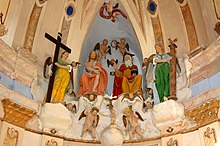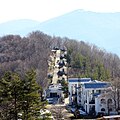





A calvary, also called calvary hill, Sacred Mount, or Sacred Mountain, is a type of Christian sacred place, built on the slopes of a hill, composed by a set of chapels, usually laid out in the form of a pilgrims' way. It is intended to represent the passion of Jesus Christ and takes its name after Calvary, the hill in Jerusalem where Jesus was crucified.
Contents
- Terminology
- Calvaries in the world
- Austria
- Belarus
- Belgium
- Bolivia
- Canada
- Croatia
- Czech Republic
- Ethiopia
- England
- Germany
- Greece
- Hungary
- Italy
- Lithuania
- Poland
- Romania
- Slovakia
- Slovenia
- Spain
- United States
- Wales
- See also
- References
- Literature
- External links


These function as greatly expanded versions of the Stations of the Cross that are usual in Catholic churches, allowing the devout to follow the progress of the stages of the Passion of Christ along the Via Dolorosa in Jerusalem. Each chapel contains a large image of the scene from the Passion it commemorates, sometimes in sculpture, that may be up to life-size. This kind of shrine was especially popular in the Baroque period when the Holy Land was under Ottoman Turkish rule and it was dangerous and highly difficult to make a pilgrimage to the Church of the Holy Sepulchre in Jerusalem.
Calvaries were especially popular with the Franciscan and Jesuit orders, and are most common in Italy, the Catholic regions of Germany, and Habsburg-ruled Central Europe. They were usually placed in parks near a church or a monastery, typically on a hill which the visitor gradually ascends. Italian ones are usually called a sacro monte ("holy mountain" or "hill"); there are a group of nine Sacri Monti of Piedmont and Lombardy that are especially notable; their dates of foundation vary between 1486 and 1712. Devotions would be most popular in Passion Week, before Easter, when large processions around the stations would be held, and mystery plays might also be acted. If a calvary was established in an inhabited place, it might result in a location of a new village or town. Several villages and towns are named after such a complex.[ citation needed ]











